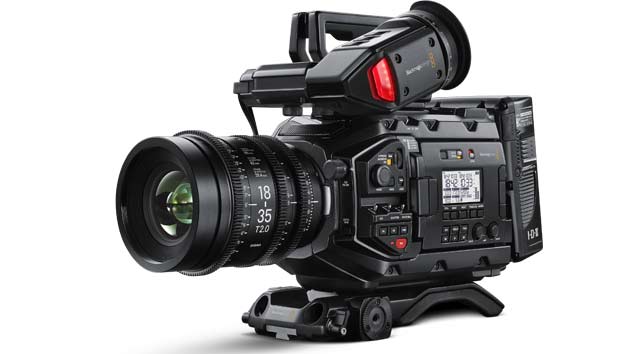Blackmagic Design is shipping the brand-new Ursa Mini Pro, a fairly dramatic redesign of its existing Ursa Mini camera.
The Ursa Mini Pro uses the same 4.6K image sensor found in the Ursa Mini, but has been designed with an array of operator-friendly buttons, knobs, and switches that were absent from the original design. They include a dial for controlling a new built-in three-position ND filter and an auto white-balance button, both next to the lens mount on the camera's front, as well as a "lock" setting that prevents changes being made by someone accidentally bumping buttons or switches. A "HFR" button gives shooters a convenient way to begin shooting slow-motion footage without navigating menus and changing settings.

Also new is a status display — a backlit monochromatic LCD screen was selected for its high visibility under difficult lighting conditions, Blackmagic said. It displays timecode, frame rate, shutter angle, aperture, white balance, ISO and iris, battery charge indicator, audio level meters, and card recording status. Speaking of cards, the Ursa Mini Pro adds dual UHS-II SD card recorders to the Ursa Mini's dual CFast recorders. CFast cards are required for 12-bit raw recording, while SD cards can handle 4K ProRes or HD raw.
 The $5,995 camera comes with an EF lens mount, but has been designed for interchangeability, with a PL mount ($245, pictured at right) and B4 mount ($385) available as accessories.A $79 "shim kit" is available with a set of shims allowing tiny adjustments to the flange focal distance for the different mounts.
The $5,995 camera comes with an EF lens mount, but has been designed for interchangeability, with a PL mount ($245, pictured at right) and B4 mount ($385) available as accessories.A $79 "shim kit" is available with a set of shims allowing tiny adjustments to the flange focal distance for the different mounts.
Fitting a new mount on the camera is not a complex undertaking, the company said — during a press conference introducing the camera, Blackmagic CEO Grant Petty demonstrated the relatively straightforward process for making the change during a shoot using a Torx screwdriver. That's key to Blackmagic's pitch for the Ursa Mini Pro as "three cameras in one" — equally suited to film-style, broadcast and studio applications. And every Ursa Mini Pro comes with DaVinci Resolve Studio.
Speaking of Resolve, this week also saw the color-grading software get updated to v12.5.5, including a new software-only Linux version for Red Hat and CentOS 6.8 or 7.2 installations.
In bigger Resolve news, the company released two new portable hardware control panels.

At $995, the USB-powered DaVinci Resolve Micro Panel is aimed at users who color-correct shots during the edit. It takes up less space, so that it can fit on a desktop along with a keyboard, but offers hardware controls — including 12 knobs dedicated to primary color-correction features — aimed in part at making primary color-correction easier and more attractive to Resolve users.

One step up the chain is the $2,995 DaVinci Resolve Mini Panel, which goes the Micro one better with two built-in five-inch LCD screens, each with its own array of buttons and knobs. It's designed to be moved around between workstations at a facility, or to be carried by freelancers doing color work on workstations that aren't part of a dedicated color suite.
Both of the new panels feature USB-C connectors, but a USB 3 to USB-C cable is included. While the Micro can be powered over USB, the Mini uses AC power or four-pin XLR 12V DC power. It can also control a Resolve workstation via Ethernet, rather than USB, and supports power over Ethernet.
Meanwhile, for dedicated color-correction suites, Blackmagic will continue to offer the $29,995 DaVinci Resolve Advanced Panel, with three control surfaces featuring every key, knob, trackball and ring you can think of.
In order to use either of the new control panels, you'll need to update to Resolve 12.5.5. Here's what's new in that version:
What's new in DaVinci Resolve 12.5.5
- Added support for the DaVinci Resolve Mini Panel
- Added support for the DaVinci Resolve Micro Panel
- DaVinci Resolve is now available on CentOS 7 and RHEL Linux
- Added CentOS 7 and RHEL Linux support for DaVinci Resolve Studio Mac and Windows licenses
- Added support for installing DaVinci Resolve Advanced Linux on standalone CentOS 7 or RHEL installations
- Improved USB connectivity with DaVinci Resolve Advanced Panels
- Added support for URSA Mini Pro 4.6K media
- Added support for Cintel Reader
- Added support for adaptive scanning speed for Cintel when disk I/O is slow
- Improved playback and seek performance of MXF OP1a and OP1b files
- Added support for channel level fine tuning with ARRI SDK debayer
- Added support for track names in ProTools AAF export
- Addressed an issue with Compound Nodes on Stereoscopic 3D projects
- Addressed an issue with adding a flag to multiple clips in the Color Page
- Dragging a node from a Still to the node graph now follows the gallery keyframe setting
- General performance and stability improvements
With these new launches alongside last month's announcements, is Blackmagic going to have anything left to announce at NAB? Actually, if previous years set any guidance, there will be plenty of surprises in store in Vegas next month. Blackmagic always has one of the most commanding lists of new gear at NAB, so it makes sense for the company to ship a few items in advance just so there's less chance of them getting lost in the whirlwind of news that opens the show.
Blackmagic Design: blackmagicdesign.com
Did you enjoy this article? Sign up to receive the StudioDaily Fix eletter containing the latest stories, including news, videos, interviews, reviews and more.











Leave a Reply